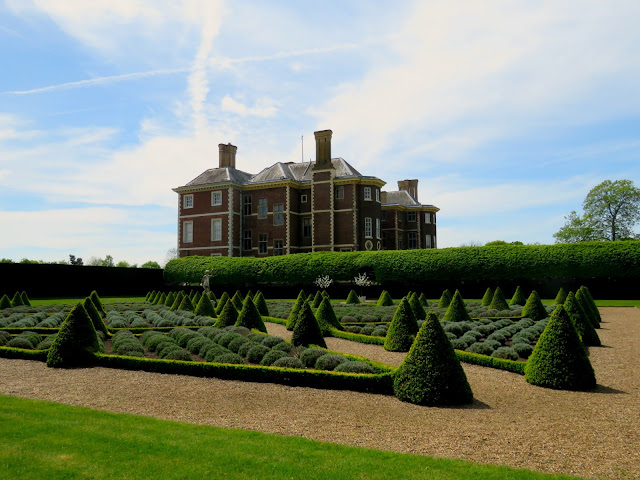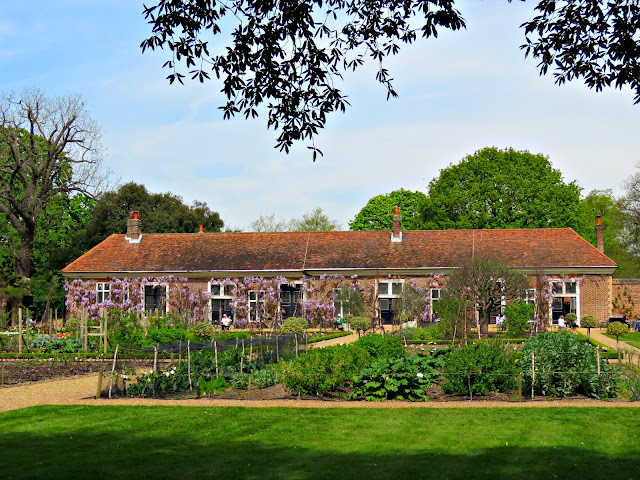 |
| Ham House, Richmond viewed from the Duchess's Garden |
And I guess if a house's been standing since 1610, just playing the statistics there's got to have been one or two residents over that length of time who were reluctant to move on - especially when the setting's as splendid as this one. So if you're going to go looking for spooks and ghosts and things that go bump in the night ... then this house is probably a pretty good place to start.
I went there last Friday with my cousin Clare for a girls' day out, and whilst we saw neither spook nor ghost nor ghoul, we had a grand old time.
It's an amazing house, the earliest parts of which date from 1610. The Murray family who lived here were staunch Royalists. Their allegiance is apparent from the carving on their very impressive front door.
They set out the date on which the house was built, 1610, and followed on with the declaration: Vivat Rex, Long Live the King. Back in the day that was a very political statement to make.
Old Man Murray, or William Murray, 1st Earl of Dysart, to give him his proper name and title was educated with the young Prince Charles Stuart, second son of James VI of Scotland who became James I of England on the death of good Queen Bess. Like many of the Stuart courtiers he was a Scotsman. The story goes that when the young prince was naughty or didn't learn his Latin grammar well enough, his friend, William Murray, would get beaten in his place. It would have been an act of lèse majesté for the prince's tutor, a mere subject ... a commoner, to discipline someone of the royal blood. Instead he would seize the prince's friend and confidante, William Murray, and beat him in place of the prince. Poor William was - quite literally - the Prince's whipping boy.
William, like Charles I, was a great connoisseur of the arts. Their tastes were probably honed and refined together by the same art masters and influences during their shared childhood years.
During the English Civil War, William Murray, was strongly and conspicuously allied to the wrong side. Following the collapse of the Royalist cause in 1649 he was forced to seek sanctuary abroad. His formidable daughter and heiress, Elizabeth, held things together at home and the family managed to hold onto their estate during the Commonwealth. She befriended Cromwell, the Lord Protector, whilst still maintaining a coded correspondence with the exiled Charles II.
And then, on the restoration of the monarchy, Ham House's moment came. Elizabeth, who married the Duke of Lauderdale, an influential player at Court, in 1672, set about turning Ham into one of the grandest houses in England with elaborate formal gardens to match. Royal apartments were built and the house became a showcase for the power couple who lived in it. Ham's happy golden age lasted for the better part of a decade, coming to a sad end amidst mounting debts and declining political influence on the death of the Duke.
They say that one of the resident ghosts is that of Elizabeth, who has from time to time been seen walking down the stairs in the early evening, and returning to her apartments on the first floor in the dead of night. Dressed in the black satin of mourning for her dead husband, her appearance is often accompanied by the faint trace of her rose cologne.
But on Friday the predominant floral fragrances came from the abundance of bluebells and the ancient wisteria vine in full flower on the walls of the orangery - now a tea room.
The orangery was built at the southern end of the kitchen garden in 1674, and is the earliest surviving example of its kind in England. Back then oranges were something of a national obsession - both as food and as decoration. Orange, lemon and pomegranate trees, planted in tubs, overwintered inside and were then be moved out onto the terrace to enjoy the kinder weather of late spring and summer.
Clare and I were very taken with the English asparagus flourishing in one of the beds in front of our table.
Definitely looking good enough to eat ...
All the best for now,
Bonny x











What a great and grand place. I enjoyed your photos very much.
ReplyDelete